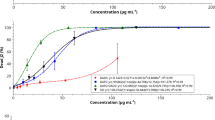Abstract
Several compounds that retard the larval growth of the tomato fruitworm,Heliothis zea (Boddie) have been isolated and identified from tomato leaves,Lycopersicon esculentum Mill. The major allelochemics are α-tomatine (I), chlorogenic acid (II), rutin (III), and a new caffeyl derivative of an aldaric acid (IV). The isolation, analyses, and toxicity of these compounds toH. zea are presented.
Similar content being viewed by others
References
Blout, B.K. 1933. The colouring matter on the stem of the tomato.J. Chem. Soc. 1933:1528–1529.
Chan, B.G., Waiss, A.C., Jr., Stanley, W.L., andGoodban, A.E. 1978a. A rapid diet preparation method for antibiotic phytochemicals bioassays.J. Econ. Entomol. 71:366–368.
Chan, B.G., Waiss, A.C., Jr., Binder, R.G., andElliger, C.A. 1978b. Inhibition of lepidopterous larval growth by cotton constituents.Entomol. Exp. Appl. 24:294–300.
Cosenza, G., andGreen, H.B. 1979. Behavior of the tomato fruitworm,Heliothis zea (Boddie), on susceptible and resistant lines of processing tomatoes.Hortic. Sci. 14:171–173.
Elliger, C.A., Chan, G.B., andWaiss, A.C., Jr., 1980. Flavonoids as growth inhibitors: Structural factors governing toxicity. Naturwissenshaften. 67:338–9.
Fery, R.L., andCuthbert, F.P., Jr. 1975. Antibiosis inLycopersicon to tomato fruitworm (Heliothis zea).J. Am. Soc. Hortic. Sci. 100:276–278.
Fountaine, T.D., Irving, G.W., Poole, R.M., andDoolittle, S.P. 1948. Isolation and partial characterization of crystalline tomatine, an antibiotic agent from tomato plant.Arch. Biochem. 18:467–475.
Politis, J. 1948. Distribution of chlorogenic acid in Solanaceae and the organs of these plants.Compt. Rend. 229:692–693.
Roddick, J.G. 1974. The steroidal glycoalkaloid α-tomatine.Phytochemistry 13:9–25.
Todd, G.W., Getchum, A., andCress, D.E. 1971. Resistance in barley to greenbug,Schizaphis graminum L. Toxicity of phenolic and related compounds and related substances.Ann. Entomol. Soc. Am. 64:718–722.
Waiss, A.C. Jr., Chan, B.G., Elliger, C.A., Wiseman, B.R., McMillian, W.W., Widstrom, N.W., Zuber, M.S., andKeaster, A.J. 1979. Maysin, a flavone glycoside from corn silks with antibiotic activities toward corn earworm.J. Econ. Entomol. 72:256–258.
Williams, W.G., Kennedy, G.G., Yamamoto, R.T., Thacker, J.D., andBordner, J. 1980. 2-Tridecanone: A naturally occurring insecticide from the wild tomatoLycopersicon hirsutum f. glabratum.Science 207:888–889.
Author information
Authors and Affiliations
Additional information
Reference to a company and/or product named by the department is only for purposes of information and does not imply approval or recommendation of the product to the exclusion of others which may also be suitable
Rights and permissions
About this article
Cite this article
Elliger, C.A., Wong, Y., Chan, B.G. et al. Growth inhibitors in tomato (Lycopersicon) to tomato fruitworm (Heliothis zea). J Chem Ecol 7, 753–758 (1981). https://doi.org/10.1007/BF00990307
Received:
Revised:
Issue Date:
DOI: https://doi.org/10.1007/BF00990307




